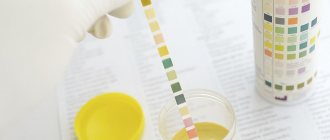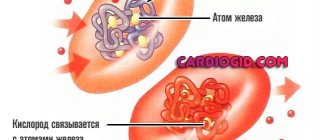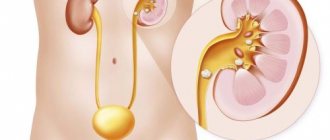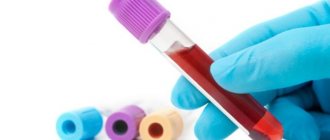Home / Types of cystitis
Back
Published: 08/07/2020
Reading time: 16 min
0
129
- Urinalysis according to Nechiporenko: the essence of the method
- Why give it up?
- What is the difference between the Nechiporenko analysis and a general urinalysis
- What can be discovered using Nechiporenko analysis
- Preparation in the evening
- What to do in the morning?
- How to collect and submit urine for analysis How to collect urine for analysis according to Nechiporenko
- Preparing the Sterile Container
- What should you not eat the night before?
- Hygiene measures
- How long to store
- How much urine is needed for analysis and how long can it be stored?
- In children
- Norm of analysis according to Nechiporenko and possible consequences for deviations in children and adults
- Leukocytes
Urinalysis according to Nechiporenko: the essence of the method
Urinalysis according to Nechiporenko is usually prescribed based on the results of a general urinalysis - if the data from the general analysis exceed the norm. The Nechiporenko analysis will either confirm the existence of the disease or allow the results of the general analysis to be interpreted as a random deviation.
The main indicators of urine analysis according to Nechiporenko - leukocytes, erythrocytes, cylinders - are assessed not simply by counting these elements that are in front of the eyes at the time of the study, as in a general urine analysis. When analyzing according to Nechiporenko, their number is determined per 1 milliliter of urine (counting is carried out using a special counting chamber).
It is also important that a strictly average portion of morning urine should be taken for analysis. This allows you to exclude the influence of random factors and get a picture of the real state of the urinary system.
It is equally important that the collected material reaches the laboratory within two hours.
All this together makes urine analysis according to Nechiporenko an informative and accurate diagnostic method.
The essence of the technique and the difference from a general urine test
During the patient’s initial visit to the doctor to make a diagnosis, he is prescribed general tests, which, however, may not always show an accurate picture of the state of the body. One of them is a general urinalysis - a study of urine (fluid produced by the kidneys).
When conducting this analysis, the following indicators are assessed:
- transparency;
- color;
- smell;
- density;
- biochemical characteristics of urine.
If the attending physician finds abnormalities in the results of a general urine test (some indicators exceed the norm, or components are found that are not found in the urine of a healthy person at all), the patient should be prescribed additional tests. For this purpose, analysis is carried out using the method of Nechiporenko and Zimnitsky.
Urinalysis according to Nechiporenko is a microscopic examination of urine sediment, which determines the level of leukocytes, erythrocytes and casts in 1 ml of material. This method is more accurate than OAM and is used to clarify the diagnosis: assess the functioning of the kidneys and urinary tract, confirm or deny the presence of infection.
A healthy person has the following characteristics:
| Cells | Quantity in 1 ml |
| Leukocytes | up to 2×106 |
| Red blood cells | 1×106 |
| Cylinders | 0,2×106 |
Deciphering an analysis using this method is the basis for making serious diagnoses, so it is necessary to thoroughly prepare for taking it.
If your doctor recommends that you undergo this type of test, you shouldn’t panic right away—maybe it’s just a precaution.
What is the difference between the Nechiporenko analysis and a general urinalysis
The first and main difference is that this analysis requires an average portion of urine.
What does it mean?
The average portion does not contain urethral washout or bladder sediment.
Second, the counting of elements contained in the liquid is carried out in a special way similar to the counting of blood elements. Moreover, what is found in a single quantity when studying a sample under a microscope, for example, in the OAM results is written as: 3 red blood cells in the field of view, then here a similar parameter will look different. Counting is carried out from 1000 or more.
Of course, not all elements of the collected urine are studied, but only some and they are calculated using a special formula, according to which the norm is:
- red blood cells: 1×106 in 1 ml
- leukocytes up to 2×106 in 1 ml
- cylinders up to 0.2×106 in 1 ml
How to take a sample from children
The algorithm is the same as for adults: first you need to wash yourself thoroughly with warm water without soap.
In order not to contaminate the sample with excess bacteria, when washing, boys need to move the foreskin and expose the head of the penis, girls need to spread the labia and wash themselves so that the water flows from front to back (otherwise bacteria from the anal area can get into the urethra and vagina).
If the child is accustomed to visiting the toilet independently, he must be instructed, explaining all the rules for washing and how to correctly collect the analysis.
How to correctly take urine tests according to Nechiporenko for children who do not yet go to the toilet on their own: as a rule, taking urine tests according to Nechiporenko is rarely prescribed for children under 3 years old, since it is difficult for them to collect urine correctly. More often, the total portion is collected in special urine collection bags, which are examined.
Urine squeezed from diapers or diapers is not suitable. Also, for urine analysis according to Nechiporenko, it is not recommended to collect urine from a pot - even if you wash it very well, microorganisms may remain and distort the results.
What can be discovered using Nechiporenko analysis
Using this method of laboratory and clinical research, it is possible to detect sediment from certain cellular and non-cellular elements in urine. By calculating the ratio of these elements and the level of their content in biological fluid , we can draw certain conclusions about the functional state of the kidneys and urinary system.
When examining urine according to Nechiporenko, the basic indicators are the following::
- Red blood cells are the formed elements of blood. Normally, they should not be present in the urinary sediment, or they may be contained in microscopic quantities. If a significant number of red blood cells are found in the urine, this may be a sign of an existing pathology.
- Leukocytes are also the formed elements of blood. An increase in the number of leukocytes in the urinary sediment is a sign of an inflammatory process. Thus, the human immune system reacts to the invasion of viral and bacterial agents and foreign bodies.
- The cylinders are predominantly protein formations. Their shape and appearance can vary significantly. Normally, a healthy person should not have cylinders. The appearance of these elements indicates serious renal pathology.
Leukocytes and erythrocytes according to Nechiporenko
If the presence of an excessive number of cylinders in a urine test according to Nechiporenko indicates exclusively kidney damage, then changes in leukocytes and erythrocytes may indicate diseases of other organs of the genitourinary system.
For example:
- Inflammation of the renal pelvis;
- Damage to the ureters;
- Bladder diseases;
- Pathology of the internal genital organs in men (prostate, seminal vesicles).
Diseases of the urethra are not included in the list of those that can be determined by urine analysis according to Nechiporenko, since the first portion of urine, which removes all the cellular elements from the urethra, is not collected.
The importance of studying leukocytes is also very great. Leukocyturia (when the number of leukocytes in 1 ml of urine exceeds 2000 cells) can have varying degrees of severity. If there are so many leukocytes that they cannot be counted, they speak of pyuria (pus in the urine). Such changes indicate a pathological inflammatory process in the kidneys or genitourinary tract. The more leukocytes are detected, the more active the inflammatory process.
It could be:
- Pyelonephritis – inflammation of the renal-pelvic complex;
- Inflammatory processes in the ureters, bladder and renal pelvis in the presence of stones in them;
- Cystitis is an inflammatory lesion of the bladder mucosa;
- Sluggish glomerulonephritis is an inflammation of the renal parenchyma of non-infectious origin;
- Kidney abscess and paranephritis are purulent diseases of the kidneys and perinephric tissue.
As for red blood cells, an increase in their content in the urine is called hematuria (when the number of red blood cells in 1 ml of urine exceeds 1000 cells).
It can be presented:
- Microhematuria is a slight increase in the number of red blood cells relative to the normal value. Urine does not visually change its color;
- Macrohematuria - there are so many red blood cells that it is very difficult to count them. This type of urine is red in color;
- Fresh red blood cells. This means that they retain their structure and are similar to those that can be seen under blood microscopy;
- Leached red blood cells are destroyed blood cells that can be represented by individual fragments of red blood cells;
It is extremely important to decide on the specific type of red blood cells. After all, fresh red blood cells in the urine always indicate either their active sweating through the renal barrier, or damage to the mucous membrane of the urinary tract
This is possible with toxic damage to the kidneys, glomerulonephritis, stones in the kidneys, ureters and bladder, disintegrating tumors of these organs.
Leached red blood cells indicate that their source is the kidney or long-term bleeding from the mucous membranes of the urinary tract. In the second case, not only leached red blood cells will be recorded, but also fresh ones.
Author of the article:
Education: Moscow Medical Institute named after. I. M. Sechenov, specialty - “General Medicine” in 1991, in 1993 “Occupational diseases”, in 1996 “Therapy”.
‹
Sensory integration as a method of treating disorders in child development
5 best recipes for nail fungus
›
Preparation in the evening
This type of examination involves studying the composition of the average portion of morning urine. But to take it you need to start preparing the day before. What should be done?
- Pay attention to the food you are going to have for dinner. You should not eat foods that can change the color of your urine. These are vegetables and fruits of bright colors: vinaigrette beets, carrots, pomegranate, plums.
- Before the examination, you should limit yourself in physical activity.
- You should not take diuretics in the evening before donating urine. They can affect the chemical composition of urine.
- Prepare the container in which you are going to collect urine. The ideal option for this is special sterile containers sold in pharmacies. They are made of transparent plastic and can be different in size and configuration. You can see examples of such containers in the photo. But you can also use ordinary small glass jars to donate urine. They need to be washed thoroughly and boiled in clean water for several minutes.
Collection rules
In order for the Nechiporenko test to show an objective result, it is necessary to adhere to the rules for collecting material and preparing for analysis. The doctor referring the patient for further examination should talk about them.
Preparation begins 1-2 days before the urine test. Strong physical exertion and stressful situations should be avoided. You need to give up alcoholic beverages and smoking. Doctors recommend not taking diuretics on the eve of the test, and excluding from the menu foods that can change the color of urine not only in children, but also in adults:
- beets;
- carrot;
- green asparagus;
- blueberries;
- strong black tea.
The test should not be performed on women who are about to start their period or have already started their period. At the end of the “critical days”, it is also worth holding off on going to the laboratory for 1-2 days.
Some time may pass after the cystoscopy. Submission of urine for analysis is possible when the urethral mucosa is completely restored.
Collecting urine for testing is not difficult. To get a reliable result, you need to prepare a sterile container with a volume of 150-200 ml in advance. This can be a plastic container purchased at a pharmacy kiosk, or a glass jar with a lid.
For analysis you will need morning urine. To make a fence, you need to follow simple steps.
- Thoroughly clean the external genitalia, rinsing off any remaining soap.
- Collect an average portion of urine in a container (take 30-40 ml), releasing the first and last into the toilet.
- Deliver the biomaterial to the laboratory where microscopy is performed no later than 2-3 hours after collection.
It should be remembered that donating urine prepared in advance does not make sense. The analysis will be biased.
You can pick up the results of the study in the laboratory a few hours later on the same day when the material is submitted. Some centers provide data within 24 hours.
Urine collection technique
To correctly collect the analysis according to Nechiporenko, take a medium portion of urine - it will not contain sediment from the bladder and washout from the urethra. This algorithm of actions will help to obtain the most accurate research results.
There are differences between how urine is collected in an adult and in children, especially infants.
In children
The process of collecting urine from children, especially very young infants, is quite problematic. To make this task easier, urinals were invented, which differ depending on the sex of the baby. After collecting the urine, it is placed in a sterile container and transported to the laboratory. In this case, it is impossible to collect an average portion of urine, which must be taken into account when deciphering the analysis results.
Urinal for girls
Urinal for boys
Galina Nikolaevna Kuznetsova, a laboratory diagnostics doctor at the Visus-1 clinic, will tell you how to properly take a urine test according to Nechiporenko.
In adults
To collect urine according to Nechiporenko from an adult, start urinating into the toilet, collect a medium portion of urine, without stopping urination, into a previously prepared sterile container, finish the process, again, into the toilet.
Collect morning urine excreted immediately after waking up.
Preparing for analysis
In order for the patient and the attending physician to be able to decipher the Nechiporenko test, the patient must properly prepare for it.
- After a person has been given a referral for testing, he must adhere to a diet: do not eat fatty, fried, salty foods, do not drink alcohol. You should not eat foods that will change the color of urine (beets, artificial dyes).
- You should not engage in excessive physical activity on the eve of the test.
- If a woman is menstruating at the time the test is prescribed, the urine test should be rescheduled. Otherwise, the test will be false positive for the presence of red blood cells.
- The study is carried out before instrumental tests on the urinary system or 10-14 days after them.
- 5 days before the analysis, all medications are discontinued. This is especially true for diuretics, diuretics, and vaginal suppositories. If there are medications that cannot be stopped for health reasons, you must notify your doctor and laboratory assistant about this.
- The material is collected on an empty stomach.
- If the patient has untreated inflammatory diseases of the urinary system, testing is postponed.
Urine collection from adults - men, women, pregnant women
After receiving a referral for a test, you need to ask your doctor how to properly take morning urine.
There are rules for passing urine that must be followed in order for the results of a urine test using the Nechiporenko method to be reliable:
- urine is collected in the morning immediately after waking up;
- before emptying the bladder, wash the genitals (labia or head of the penis);
- women (pregnant and not pregnant) need to insert a tampon into the vagina so that the mucous secretion from it does not get into the liquid;
- the average portion of urine is collected in a container, that is, the liquid between the first urination and the end (you need to start urinating into the toilet, then into the container for a few seconds and then back into the toilet);
- Women need to spread their labia with clean hands when emptying their bladder.
After collecting the biomaterial, the container is signed (name, date and time of filling). The sample is delivered to the laboratory immediately. The smaller the time difference between collection and delivery of the sample, the more accurate the analysis will be.
If the liquid was collected much before the laboratory opened (for example, the child emptied his bladder early in the morning), the container is placed in the refrigerator for no more than 8 hours.
You can find out from the laboratory assistant how long the analysis takes and when it can be picked up.
Urine collection in children
Fluid collection differs between adults and children. If collection is carried out from infants, use a special urinal for children. It is glued with the sticky side around the penis of boys or the labia of girls. After emptying has occurred, the urinal bag is peeled off. The liquid is poured into a plastic container.
If your child does not empty his bladder for a long time, you can turn on the water. In infants, the sound of water triggers the urination reflex.
What not to do when collecting urine
The main difference between the general analysis and the sample according to Nechiporenko’s method is that the latter is collected in the middle portion. The study does not require urine from all departments.
For all types of urine tests, low or high pH soap should not be used for washing. The acid-base state of urine will change (become acidic or alkaline). The urine container must be sterile; jars should not be used. It contains foreign microorganisms that will change the result of the analysis.
Determination of organic elements in the laboratory
Analysis according to Nechiporenko is done according to an algorithm. First, the acid-base environment of urine is determined. An alkaline environment sometimes indicates the decomposition of formed elements. After determining the pH of the urine, 10 ml of the test material is poured and centrifuged for 3 minutes. Thus, the top layer is separated from the sediment. Normally, the sediment should be 0.5 - 1 ml. It is thoroughly stirred and placed in a counting chamber.
If the count is carried out in Goryaev's chamber, the following technique is used:
- The exact number of red blood cells, leukocytes and cylinders is obtained by calculating using the formula: the number of formed elements that were counted in the chamber is divided by the volume of the chamber in μl (in Goryaev’s device this figure is 0.9).
- After establishing this indicator, the amount of each formed element in 1 ml of urine is calculated: the number of elements in 1 μl of urine with sediment is multiplied by the volume of urine with sediment and divided by the amount of urine that was taken for centrifugation.
This technique allows you to give accurate and informative results. If the patient does not know how to submit material for research correctly, the risk of false readings increases. However, the accuracy of laboratory diagnosis depends not only on how the patient collects urine, but also on compliance with the counting algorithm.
Often the technique is used to accurately identify pyelonephritis or glomerulonephritis. Determination of the formed elements in 1 ml of material also provides information about the presence of urolithiasis in the patient, toxicosis in pregnant women, arterial hypertension, and heart failure. Normally, the number of red blood cells does not exceed 1000 per ml of urine, leukocytes - no more than 2000 per 1 ml, and cylinders - no more than 20 per 1 ml. Exceeding these indicators indicates illness or improper urine collection.
To make the indicators informative, formed elements are differentiated from yeasts and inorganic oxalates.
What is it prescribed for?
As described above, the Nechiporenko research method is used as a diagnostic one. It is usually prescribed after a general analysis (if any deviations were identified in the indicators) in order to obtain a more detailed picture from the collected data for making a diagnosis.
Deviation from normal readings indicates the presence of a disease
This analysis is also done to monitor the effectiveness of the therapy. The data is interpreted as follows:
- The norm of leukocytes is up to 2000 per 1 ml; if there are more of them, then an inflammatory process occurs. Increased levels are observed with prostatitis, pyelonephritis, urolithiasis, and cystitis.
- The norm of red blood cells is up to 1000 in 1 ml. If the readings are higher, then there is every reason to suspect serious inflammation with bleeding.
- According to the established norm, 1 ml of urine can contain up to 20 hyaline casts. If more of them are found, then inflammation is probably actively developing in the renal pelvis.
It is important to understand that only a doctor can correctly understand the analysis. There is no point in trying to find out on your own from an analysis whether you have cystitis or not - a comprehensive examination is required to make a diagnosis. In addition, the results may be erroneous (if the patient did not know how to properly collect urine or it was transported incorrectly).
How long does the Nechiporenko analysis take?
In most cases, a form with final urine results is given to the attending physician or patient the next working day. The delivery of results may be delayed by an additional 1-2 days due to increased workload in the laboratory in which the procedure is performed.
A number of medical clinics provide an express service, which is in demand when you need to urgently receive a transcript. An accelerated urine diagnosis of this type is prepared in literally 1.5–2 hours. Tests of people in serious condition are examined even faster - in a few tens of minutes.
Preparation
- Do not take any pills (or other medications) before collecting urine, as they may affect the results. If you cannot stop taking them, you need to inform your doctor. There are cases that cystitis due to medication cannot be determined by analysis, although there are symptoms.
- Before collecting a urine test according to Nechiporenko, you need to wash yourself with warm water, otherwise the bacteria that have accumulated on the external genitalia may end up in the container with urine. Because of this, the indicators may be false.
- You should not use any gels or foams for washing, especially those with an antibacterial effect. If even a microscopic part of such products gets into the container, this can lead to the death of some microorganisms. The result is that the research results are distorted. If you do use regular mild soap, you need to rinse it off very well with water and then wipe dry.
- The day before passing urine according to Nechiporenko, it is not recommended to eat foods that contain a lot of natural dyes (carrots, beets). You should also refrain from spicy and spicy foods and drinking alcohol.
If the preparation for taking the sample was not carried out, please inform your doctor. To obtain reliable results, he may postpone the test to another day.
Explanation: normal indicators
The Nechiporenko method allows you to determine the number of cellular structures in urine, which is an important diagnostic indicator.
The urine analysis standard is determined for the following elements contained in the biomaterial:
- red blood cells - their normal number in the material of a healthy person should not exceed 1000 per 1 ml;
- Normally there are no more than 2500 leukocytes per ml;
- the norm for hyaline cylinders is no more than 20 in 1 ml;
- other types of casts are not detected in healthy urine.
If any indicator in the sample is outside the normal range, this indicates a pathology of the genitourinary system.
Normal values do not depend on gender and age, that is, they are the same for men, women, and children.
Often, with frequent or painful urination, pain in the lumbar region, the test is prescribed to women during pregnancy and even during childbirth. This allows problems to be identified at the earliest stages.
Norm of analysis according to Nechiporenko and possible consequences for deviations in children and adults
It is worth considering another significant point, according to which urine analysis using the Nechiporenko method has a serious error of 10%.
| indicators | norm | consequences if the norm is too high |
| leukocytes | 1.900 – 2.100 cells/ml (0-5 in field of view) | with leukocyturia (increased white blood cell count):
in men: prostatitis in women: vaginitis, endometritis, thrush, trichomoniasis during pregnancy: in the first weeks, since the body perceives the fetus as a foreign body and natural defense mechanisms are activated, but with a strong and prolonged deviation from the norm, serious inflammatory processes are possible. in children in addition to the above: with allergies, putrefactive infestation, diaper rash in infants: reflux, when urine stagnates in the kidney area and there is a reverse diversion (with improper development of the genitourinary tract) |
| red blood cells | 900 – 1,100 cells/ml (0-3 per field of view) | with hematuria (increased content of red blood cells in the urine):
in men: prostatitis in women: cervical erosion The following conditions can provoke the release of red blood cells into the urine:
|
| cylinders | up to 20 units/ml hyaline | If any others (except hyaline) are found, this is a pathology. The excess of hyaline indicates the onset of inflammation in the renal pelvis - pyelitis. In combination with leukocytes, it indicates bacterial pyelitis; if, together with everything described above, many red blood cells are found, then acute purulent pyelonephritis progresses. If other casts were found (granular, waxy, erythrocyte, etc.), then serious pathological processes progress, with a focus of inflammation in the kidneys. In other words, their presence indicates:
|
Nechiporenko - norm of indicators
Urine analysis indicator:
- Cylinders are normal - no more than 20 per 1 ml
- Red blood cells are normal - no more than 1000 per 1 ml
- Leukocytes are normal - no more than 2000 per 1 ml
Analysis in pregnant women
A urine test according to Nechiporenko may be prescribed for pregnant women to clarify the diagnosis; if a preliminary general urine test showed deviations from the norm, treatment needs to be adjusted and monitored. The period of gestation is very important for the expectant mother; the woman’s body is preparing to become a mother. Changes occur in the uterus, hormonal levels change, all this requires close monitoring by a doctor. The answer to the tests can be received within 2 hours.
| Index | urine normal for pregnant women |
| Amount of urine | 150-200 ml |
| Color | straw or amber yellow |
| Transparency | Full |
| Density | 1.010 – 1.030 |
| Acidity Hp | 5.0 – 7.0 |
| Protein in the urine of a pregnant woman | No more than 0.033 g/l |
| Sugar | Absent |
| Bilirubin | Absent |
| Urobilinogen | Footprints |
| Ketone bodies | None |
| Red blood cells | 1-2 in sight |
| Leukocytes | No more than 5 in sight |
| Epithelium | Single cells of transitional and squamous epithelium in the field of view |
| Cylinders | Single hyaline casts in the field of view |
| Salts | Single amorphous urates and oxalates |
Normal in children
| normal indicators in children | |
| red blood cells | 1 thousand in 1 ml |
| leukocytes | 2-4 thousand in 1 ml |
The purpose of the Nechiporenko analysis in children is to suspect chronic and hidden diseases of the kidneys, urinary tract, hematuria and leukocyturia, and to monitor drug therapy for sick children. The preparation of children is the same as for a general urine test. A diet is indicated, a ban on spicy, sour, fatty, meat. It is better not to overtire your child with games and physical activity. It is better for children not to take exams, stress is excluded. It is prohibited to take certain anticoagulants, antiplatelet drugs that affect blood clotting, as well as diuretics.
The child's test must be taken to the laboratory within 2 hours after urination.
When a doctor orders a test
If you have a disease of the kidneys or the genitourinary system of the body as a whole, the doctor gives a referral to submit a urine test according to Nechiporenko to the laboratory. But this test is taken not only when your kidney disease is detected, but also to monitor the effectiveness of the treatment.
That is why tests are taken more than once. It is not uncommon for a Doctor, after examining a general urine test, to send you for a Nechiporenko test, this means that the identified abnormalities in urine tests require detailed consideration. This is necessary for an accurate diagnosis of the patient. In an hour and a half, the analysis will be ready in the laboratory.
How to take the test correctly
The test must be taken in the morning after the morning toilet. Urine collection is performed after a scrupulous toilet of the genital organs in order to prevent errors in diagnosis. For the test, an average portion of urine is collected. First, the first amount of urine excreted, which is approximately 15-20 milliliters, is passed through, but the middle portion is placed in a prepared clean container. Before the analysis, you need to refrain from eating meat, fatty, salty, sour, alcoholic drinks, it is better to go on a diet.
Diseases that the analysis diagnoses
Cystitis is an inflammatory disease of the bladder. With cystitis, the presence of infection (bacteria) in the bladder provokes the accumulation of leukocytes in this area, designed to fight the infection. Pyelonephritis is an inflammatory disease of the kidneys in which the level of leukocytes in the urine is increased. Pyelonephritis is an infectious inflammation of the pelvis and other parts of the kidneys. Kidney stones nephrolithiasis. The presence of leukocytes in the urine indicates that infection is associated with the disease. Acute glomerulonephritis is a disease of the glomeruli of the kidneys, the main parts responsible for filtering and purifying the blood. Leads to an increase in red blood cells in the test. Chronic glomerulonephritis is characterized by the presence of red blood cells in the urine.
Tumors are often benign
- papilloma
- fibroma
- hemangioma
- and malignant.
Reasons for deviations from the norm
The origin of the disease is directly related to which urine test parameters were exceeded. The appearance of foreign particles (bacteria, proteins) may also indicate certain disorders.
Leukocytes
A critical level of white cells in urine may indicate the development of inflammatory diseases, such as:
- cystitis;
- pyelonephritis;
- vesiculitis and balanoposthitis (damage to the seminal vesicles and head of the penis, respectively);
- urethritis;
- prostatitis;
- acute pancreatitis;
- appendicitis;
- pyelitis (inflammation of the kidney calyces and pelvis);
- adnexitis (infection developing in the fallopian tubes and ovaries);
- vulvitis;
- vulvovaginitis;
- pyonephrosis (kidney suppuration);
- kidney abscess;
- bartholinitis (an inflammatory process affecting the Bartholin glands near the vagina).
No less common reasons are:
- helminthiasis (young children mainly develop enterobiasis caused by pinworms);
- amyloidosis (pathology of protein metabolism);
- allergic reaction;
- urolithiasis disease;
- cystosis;
- phimosis (severe narrowing of the foreskin in men);
- prostate adenoma;
- kidney infarction;
- pneumonia;
- diabetes.
An excess of white cells in the urine occurs with dehydration associated with blood loss, increased sweating due to infectious diseases, or vomiting with prolonged diarrhea. Very often, leukocytes are detected in the case of pregnancy and prolonged urinary retention.
In babies under one year of age, leukocyturia often appears due to diathesis or the constant occurrence of diaper rash
Antibiotics, diuretics, as well as anti-tuberculosis and non-steroidal anti-inflammatory drugs can provoke changes in the properties of urine. The results of a urine test are also distorted by the lack of proper hygienic care of intimate parts of the body and improper collection of biomaterial.
Red blood cells
Normally, urine contains practically no blood cells, and laboratory detection of such can be the cause of not only pathological changes, but also physiological factors. Among the first are:
BLD in urine analysis - what is it?
- renal or heart failure;
- hemorrhagic cystitis;
- Uronephrolithiasis (kidney and bladder stones);
- poisoning from spoiled products, poisons or heavy metals;
- acute glomerulonephritis;
- pyelonephritis;
- systemic lupus erythematosus;
- tuberculosis of the bladder and kidneys;
- hemophilia (blood clotting disorder);
- metabolic nephropathy (kidney dysfunction due to impaired metabolism);
- endocarditis (inflammation of the inner lining of the heart);
- tumors of the genitourinary organs;
- cervical erosion;
- kidney infarction;
- hydronephrosis;
- polycystic disease;
- polyposis
Red blood cells often enter the urine after abdominal injuries - severe bruises, ruptures and penetrating wounds. An excess of formed elements is sometimes observed with an insufficient amount of vitamin C in the body. The composition of urine changes when taking NSAIDs, anticoagulants and hormonal drugs.
Many people are diagnosed with hematuria associated with stress, excessive physical activity, drinking alcohol and abuse of spices. Those who are forced to work in hot environments may also experience results with excess red blood cells in their urine.
Cylinders
Each type of structural formation has its own deviations. In urine there are only a few hyaline casts, while others should be absent. An excess of the former and the presence of the latter indicates the following:
| Type of inclusions | Reasons for appearance |
| Hyaline | Toxicosis during pregnancy, long-term use of diuretics, hyperthermia (overheating of the body), severe stress, polio, rubella, measles, dehydration, kidney inflammation |
| Grainy | Vigorous physical activity, viral infections (pneumonia, smallpox, rubella, measles, mumps), autoimmune connective tissue diseases (myasthenia gravis, rheumatoid arthritis), advanced hydronephrosis, lead poisoning, glomerulonephritis |
| Waxy | Renal amyloidosis, low protein due to hepatitis, traumatic shock and protein-free diet, rejection of a transplanted kidney, renal failure |
| Red blood cells | Vasculitis, renal infarction, glomerulonephritis, lupus erythematosus, renal vein blockage, malignant hypertension (critically high blood pressure); kidney cancer (sarcoma, nephroblastoma), Goodpasture's syndrome (vascular inflammation of the lungs and kidneys) |
| Leukocyte | A rare phenomenon, it mainly indicates pyelonephritis |
| Epithelial | Poisoning with nephrotoxic substances and heavy metals, acute viral infections (including inclusion cytomegaly), kidney transplant rejection, tubular necrosis and hepatitis |
Detection of small amounts of protein, epithelium and mucus in the urine is quite acceptable. But bacteria often indicate genitourinary infections, although they may appear due to inaccurate urine collection.
Contraindications for testing
No matter how hard you try to prepare for the test, there are a number of factors that will invariably distort the results of the study and are therefore a contraindication to its conduct.
Contraindications for taking a urine test according to Nechiporenko:
- Menstruation. The problem is that menstrual blood will end up in the urine, and it will not be possible to correctly assess its composition.
- Diagnostic procedures on the bladder. These include cystoscopy and catheterization.
- Heavy physical activity or emotional stress.
- Exacerbation of allergies, especially in children.
- Presence of diaper rash on the genitals of infants.
How much urine is needed for analysis and how long can it be stored?
Please note how much urine is needed for analysis according to Nechiporenko - a portion of 20-25 g is enough. It is advisable to immediately deliver the collected amount of urine to the laboratory.
If this is not possible, short-term storage of the container with urine in the refrigerator is allowed - no more than one and a half hours. Do not allow the material to overheat - bacteria will multiply and distort the results. There is no need to freeze urine, otherwise some of the cells will be destroyed, which will also affect the reliability of the analysis.










